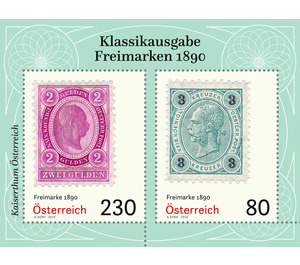Series: Classic Edition - Postage stamps 1890 - Austria / II. Republic of Austria 2019
Theme: Well-known people
| Country | Austria / II. Republic of Austria |
| Issue Date | 2019 |
| Color | multi-colored |
| Item Type | Block |
| SID | 911215 |
| Dimensions | 80.00 x 60.00 |
| In 63 Wishlists | |
Postage stamps 1890 - New denominations: New postage stamps were issued from 1st September 1890, the design once again, after the double-headed eagle shown on the 1883 issue, showing the bust of Emperor Franz Joseph in an oval frame. The new denominations had become necessary as the fees for insured letters, money orders and parcels had to be paid via postage stamps. They were issued in the following denominations: 1, 2, 3, 5, 10, 12, 15, 20, 24, 30 and 50 Kreuzer and 1 and 2 Gulden. Some denominations were issued in September 1890, the remainder at the end of the year. The 1 to 15 Kreuzer stamps remained valid for postage until 30th September 1900; those with a denomination of 20 to 50 Kreuzer until 31st August 1891, and the Gulden denominations remained in circulation until 31st January 1896. Different designs: What is particularly remarkable about this issue of stamps is that the two Gulden stamps featured a different design: while they show the bust of the emperor in profile, unlike the Kreuzer denominations his head is turned to the right and there is an additional decorative border within the oval. Overall they are slightly larger and appear narrower. The denomination is repeated in words on the bottom edge. Additionally, a different printing method was used: whilst the Kreuzer denominations were printed in a two-stage process, as for the 1883 issue (the black figures for the denomination were added in a second printing process), the denominations for the 1 and 2 Gulden stamps were produced using an intaglio printing process, a first in the history of Austrian stamps. These stamps are available with a range of perforation types. In addition to 10-count harrow perforations, they are also found with a variety of line perforations and various mixed forms. In order to protect against forgeries, a special paper was used, which had brownish-black fibres running through it but no watermark. The type of paper was changed repeatedly. Initially rather hard, yellowish-grey and glassy because of the thick layer of glue, from 1894 a smoother, softer paper and a thinner layer of glue were used. From 1898 on, both the paper and the glue were white. For the Gulden stamps there was a different copperplate etching paper. The new stamp block shows postage stamps with the denominations 2 Gulden and 3 Kreuzer on a background echoing the design of the stamps.


